Raspberry Heritage
Raspberry with a loud, beautiful and "authoritative" name. Heritage was one of the first fall varieties to be cultivated commercially. And, of course, he helped popularize the remontant raspberry among gardeners, first in America, and then around the world. For a long time, it was considered the standard for remontant varieties, a model for producing tasty, high-quality fruits. But even now, new items are often compared to it in advertising descriptions and official patents. However, mainly to show the advantage of the newcomer over the old champion.
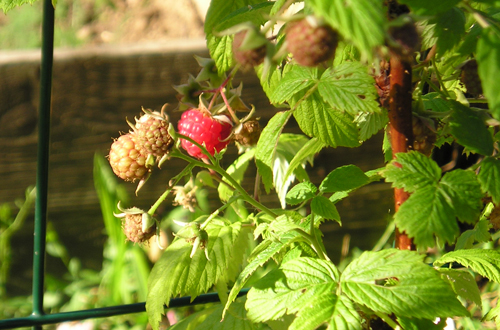
At first, our gardeners had a confusion with the names. Many thought that Heritage and Legacy were two different varieties. And the cunning sellers were in no hurry to dissuade buyers, but on the contrary told different fables about the improved version, but sometimes they just knew little themselves. In fact, everything is simple - Haritage, translated into Russian, just means “Heritage”. And of course, these are the same raspberries.
History of creation
The variety was obtained in 1969 as a result of complex artificial pollination of various varieties. Cross hybrid named NY 463 bred as a result of crossing (Milton x (Lloyd George x Newburgh) x Cuthbert) x Durham. Subsequently, it received the beautiful, meaningful name Haritage. The work was carried out at Cornell University, Geneva, New York, as part of a breeding program that continues to this day. The first variety was "Taylor" (1935), and the most recent - "Crimson Treasure", with berries of average weight already 2 times more than that of the old man Heritage. It will be implemented in the spring of 2019. Prior to that, as part of the breeding program, 2 more varieties from this series were released, the already well-known Crimson Giant and Crimson Night, as well as a remontant with pinkish-yellow Double Gold berries.
Description
Haritage is a late-ripening American-bred remontant raspberry. Fruiting on the shoots of the current and last year. The cultivation technology provides for late autumn or early spring mowing of the stems "to zero". But our hero is also suitable for growing for 2 crops, but let's make a reservation right away - his summer harvest is much less than the autumn one. The zone of direct autumn fruiting is 1/3 of the shoot.

In the southern regions, the variety begins to bear fruit from the second half of August, in other regions - from late August / early September. On the shoots of the second year, it begins to bear fruit in June. Fruiting lasts 2-2.5 months, but before frost the plant usually manages to give most of the harvest. Of course, when grown outside the northern regions and in warm, long autumn. Or when cultivated in greenhouses.
Heritage is great for both hobby gardening and commercial open field cultivation. The variety has good self-pollination, therefore it can be grown in protected ground conditions (film, glass, polycarbonate greenhouses and tunnels). Raspberries are easy to grow and adapt well to various growing conditions. But it shows the best results when planting in places well-lit by the sun, with drained, neutral or slightly acidic, nutritious soil. It responds positively to the application of mineral fertilizers and the pre-planting application of organic matter (rotted manure).
The variety has medium vigor, compact habit. Shoots are upright, strong, medium in thickness, medium thorny. Spines of medium size (2.0-2.3 mm) and density, slightly curved, dark, brownish-green in color. Stems are juicy green, with a weak waxy coating, without pubescence, by autumn they can acquire an anthocyanin hue. Ripe shoots turn light brown.
Shoots grow mainly up to 1.2-1.5 meters, but with good agricultural technology and regular watering, they reach a height of 1.7-1.8 meters. The bush is 0.8-1.2 meters wide. Heritage for the growing season produces an average number of replacement shoots (5-7 pcs), as well as a small amount of root shoots (nettles). This saves time and effort on sanitizing and trimming.
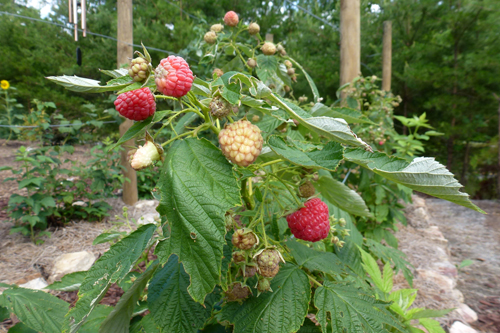
The growing laterals are slightly directed upward in relation to the central stem. They are strong, resilient, short to medium in length, light green in color. By the end of summer, they can acquire an anthocyanin hue. The average number of berries per 1 fruit branch (lateral) is 20. The shoots of this raspberry can tilt to the sides, so for the convenience of growing and picking berries, it is necessary to install a trellis or supports. Also, due to the fact that the upper part of the shoot bears abundantly in autumn, it can break off without a garter. Leaves are oval, narrow and long, medium to large in size, with an elongated pointed nose, medium to strongly curled. They are saturated green, whitish below, slightly corrugated, with finely toothed edges, consist of 5, less often of 3 leaves. Flowers are large and medium, 1.8-2.0 cm in diameter, white, collected in numerous compact clusters. The shoots of the first year bloom from July, the second year from May. Raspberry bloom lasts 19 weeks.
The variety is quite drought-resistant, has a developed root system. But for abundant fruiting, timely provision of moisture is required. Without regular watering, especially at the time of pouring the fruits, the berries will not gain their size, they will be very small. Therefore, some gardeners who rarely visit the country, according to the results of the first planting season, are disappointed in Heritage and uproot it. Organic and inorganic mulch will help protect the root system from overheating during the hot summer months, retain moisture in the root zone of raspberries and help save energy on regular weeding. And organic mulch, rotting, also enriches the soil with nitrogen and other useful substances.
Berries are one-dimensional, aligned, rounded-conical, slightly pubescent. Drupes are small, uniform, tightly linked to each other. They contain few, very small seeds, their average weight is only 1.5 mg. Fruits are rich, bright red with a pronounced glossy shine. The stalk is elongated, fully ripe berries are removed without effort. The separation is dry when picked, the fruits do not flow or crumble. The berries are firm, firm, but the flesh is juicy. The skin is thin, but strong and elastic, resistant to external mechanical damage.
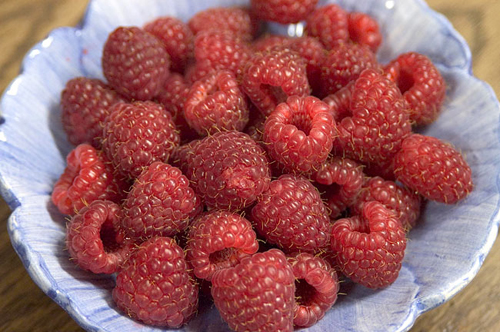
Our hero does not have a special large-fruited, which new varieties can give out. The berries are mostly medium to medium-large in size. Although frankly small fruits are enough. The weight of berries in the autumn season is mainly 2.5-3.5 grams. Interestingly, the average weight of the fruits obtained from the shoots of the current year is 3.1 grams, and on the shoots of the second year it is already less - 2.3 grams. But with regular fertilizing with complex fertilizers and moisture supply, the weight of the fruits in the autumn season can grow to 4-5 grams. The length is 1.8-2.5 cm, the width is 1.7-2.0 cm.For example, the average raspberry berry Maravilla 2-2.5 times more.
The undeniable merit of our hero is the high tasting characteristics of the fruit. The berries are sweet, but not sugary, tasty, with a slight, pleasant, refreshing sourness. The aroma is intense, truly raspberry. Tasting score 4.4-4.6 points out of 5.0 possible. The content of soluble solids in fruits (%) - 1.58, titratable acidity (% citric acid) - 9.9. Berries are versatile in use. They are eaten fresh with pleasure and used for all types of processing. It turns out delicious jam, excellent marshmallows, jams, marmalades, compotes. The fruits do not lose their consistency after thawing. Therefore, they are widely used for drying and freezing. Heritage fruits are characterized by good keeping quality and transportability.They do not burn significantly in the sun even in the south; mostly overripe, dark raspberry berries burn. The crop tolerates heat well; in cool, rainy weather, the taste does not "blur", the fruits remain sweet.
The variety is resistant to many diseases and pests of the crop, but requires several preventive treatments before flowering. After flowering, at the time of ovary and fruit pouring, it is strongly recommended to use only biological products. The variety has high frost resistance, USDA zone 4-8 (according to the US Department of Agriculture), raspberries can withstand up to -35 ° C. Fruit-bearing bushes can withstand small (-2 ° C, -3 ° C) frosts without losing the commercial qualities of the fruit.

Previously, our hero was in the lead in many respects, including yield. But now new varieties are significantly ahead of him. The yield is 2.5-3.0 kg per bush, with good and regular moisture supply, as well as a high agricultural background, the yield can reach 4-5 kg per plant. With industrial cultivation, the productivity of the variety is 14-17 t / ha. By the way, even now Heritage is actively planted on an industrial scale on large areas, but basically the entire crop is used for processing and freezing.
Strengths
- Interesting, smile-making characteristics of raspberries are posted on American sites. In particular, "deer-resistant, repellent to birds and friendly to bees." Apparently, in some states, deer are serious pests of raspberries. It would be nice to add the term "bear-resistant" to increase the sonority and solidity when characterizing our, domestic varieties.
- Stable yield indicators.
- Good self-pollination, due to which the variety can be successfully grown both in open and closed ground.
- Good adaptation to various growing conditions, relative unpretentiousness in agricultural technology. This raspberry is suitable for both hobby gardening and industrial cultivation.
- Heritage produces an average amount of root growth and replacement shoots, does not spread far from the place of growth. This all saves time and effort.
- The variety has a long history of cultivation, tested by generations of farmers and ordinary gardeners.
- The berries are sweet, raspberry-tasty, juicy, with a pronounced aroma, there is a berry aftertaste.
- The fruits are versatile in use. Suitable for both sale and all types of processing.
- Good keeping quality and transportability of berries. They are suitable for long distance transport, especially when cooled and kept at a stable temperature. Usually this figure is + 2 ° С.
- Raspberries have high frost resistance, good resistance to many diseases and crop pests.
- In cool, rainy weather, the berries retain their flavor and quality.
- The ability to grow the variety as a totimer capable of producing 2 crops. But I would like to make a reservation right away - our hero is very far from real tutimers, like Maravilla.
Weak sides
- Until now, many people cannot understand whether they have Heritage or not. And not only simple summer residents, but also farmers with good experience, well versed in various varieties.
- The thorniness of the stems interferes with agrotechnical measures and harvesting.
- During storage, the berry can darken, change its bright red color to dark crimson.
- Small fruit size, especially compared to many modern varieties.
- Yield indicators are at an average level.
- Late ripening, not in all regions, raspberries will be able to give a significant part of the harvest.
- It is very desirable to install a trellis or supports, the top of the stem may break off.
- A small zone of autumn fruiting, accounting for 1/3 of the shoot.
What can be added in the end - Heritage is suitable for growing in our time. But of course, you will not see berries on it that can delight with their size and appearance, as well as arouse the envy of neighbors. Alternatively, you should try to plant a couple of bushes if you have extra space in order to draw conclusions yourself. But it is better to pay attention to new products - this is not why selection is actively moving forward in order to grow varieties of 50 years ago. And one more thing - there are still a lot of raspberries on the market under the name "Harmony". Including those offered by well-known suppliers. So you have to be careful. Although, if instead of Heritage they sell you, for example, Shelf - it will only play into your hands!
Author: Maxim Zarechny.




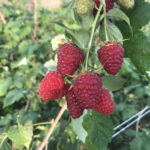
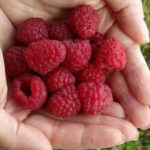



I planted this variety 4 years ago, I'm happy with the choice. Bushes do not require special care and soil. The seedlings show good growth every year. In four years, a plot of 5 to 6 out of 5 seedlings came out. Fruiting begins in July and until the end of August (Donbass). After that, the yield declines sharply. Among the disadvantages: in terms of sweetness, it loses to early one-time varieties and requires a garter.
This is a rather old variety, but in taste and aroma of berries it gives odds to many modern remontants. I like the fact that after long rains at Heriteij, the sweetness remains at a high level. I also like that the berries do not flow and are well transported. On our site there are summer varieties of raspberries and enough berries in summer. Therefore, we leave Heritage only for autumn fruiting. To achieve this, we prune all shoots near the ground in late autumn. In the spring, new shoots grow, which will give only an autumn harvest, but there are many berries, they are larger and with a rich taste. With such pruning, we also protect plantings from diseases and pests that hibernate on the shoots. Initially, such varieties were created for this. And also, I recommend not to thicken the planting of this raspberry, from this the taste is better and the yield is greater.